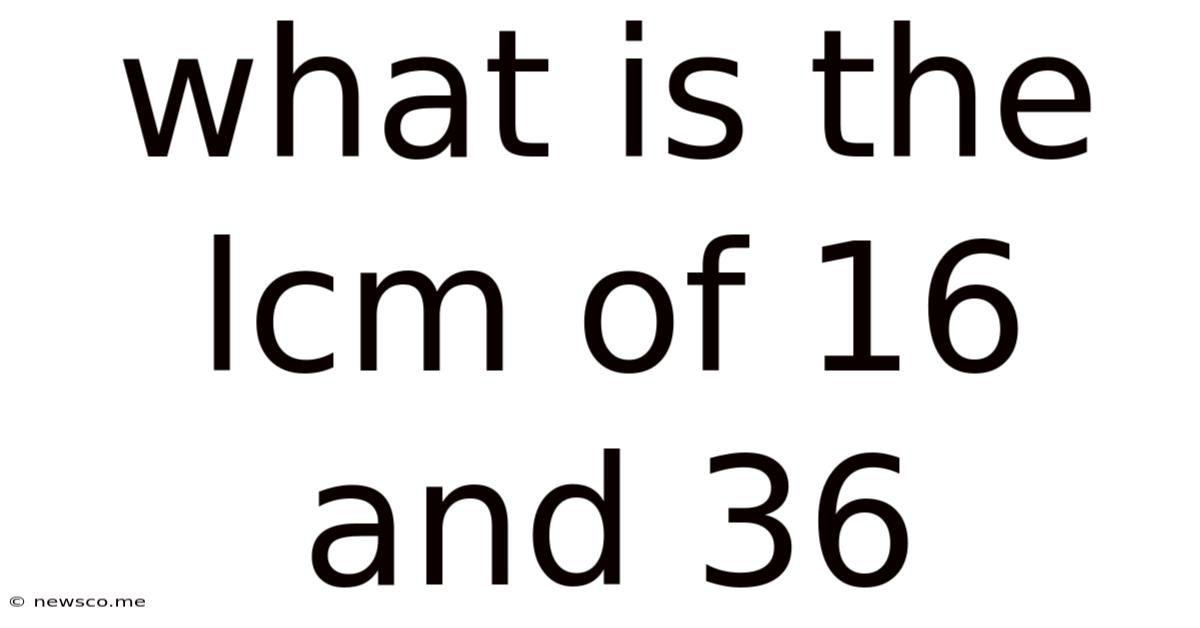What Is The Lcm Of 16 And 36
News Co
Mar 26, 2025 · 5 min read

Table of Contents
What is the LCM of 16 and 36? A Deep Dive into Least Common Multiples
Finding the least common multiple (LCM) might seem like a simple arithmetic task, but understanding the underlying concepts and different methods for calculating it is crucial for various mathematical applications, from simplifying fractions to solving complex problems in algebra and beyond. This comprehensive guide will explore what the LCM of 16 and 36 is, explain the various methods to find it, and delve into the broader significance of LCMs in mathematics and real-world scenarios.
Understanding Least Common Multiples (LCM)
The least common multiple (LCM) of two or more integers is the smallest positive integer that is divisible by all the integers. It's a fundamental concept in number theory with far-reaching applications. Think of it as the smallest number that contains all the numbers you're considering as factors.
For example, let's consider the numbers 4 and 6. The multiples of 4 are 4, 8, 12, 16, 20, 24, ... The multiples of 6 are 6, 12, 18, 24, 30, ... The common multiples of 4 and 6 are 12, 24, 36, and so on. The least common multiple, therefore, is 12.
This concept extends to more than two numbers. Finding the LCM becomes increasingly important as we tackle more complex mathematical problems.
Methods for Finding the LCM of 16 and 36
Now, let's focus on finding the LCM of 16 and 36. We'll explore several methods:
1. Listing Multiples Method
This is the most straightforward method, especially for smaller numbers. We list the multiples of each number until we find the smallest common multiple.
- Multiples of 16: 16, 32, 48, 64, 80, 96, 112, 128, 144, ...
- Multiples of 36: 36, 72, 108, 144, ...
The smallest number appearing in both lists is 144. Therefore, the LCM of 16 and 36 is 144. This method is simple to understand but becomes less efficient as the numbers get larger.
2. Prime Factorization Method
This method is more efficient, particularly for larger numbers. It involves breaking down each number into its prime factors.
- Prime factorization of 16: 2 x 2 x 2 x 2 = 2<sup>4</sup>
- Prime factorization of 36: 2 x 2 x 3 x 3 = 2<sup>2</sup> x 3<sup>2</sup>
To find the LCM, we take the highest power of each prime factor present in the factorizations:
- Highest power of 2: 2<sup>4</sup> = 16
- Highest power of 3: 3<sup>2</sup> = 9
Now, multiply these highest powers together: 16 x 9 = 144. Therefore, the LCM of 16 and 36 is 144. This method is generally preferred for its efficiency, especially when dealing with larger numbers.
3. Greatest Common Divisor (GCD) Method
The LCM and the Greatest Common Divisor (GCD) are closely related. The product of the LCM and GCD of two numbers is equal to the product of the two numbers. This relationship provides an alternative method for finding the LCM.
First, we find the GCD of 16 and 36 using the Euclidean algorithm or prime factorization.
- Prime factorization of 16: 2<sup>4</sup>
- Prime factorization of 36: 2<sup>2</sup> x 3<sup>2</sup>
The common prime factor is 2<sup>2</sup> = 4. Therefore, the GCD of 16 and 36 is 4.
Now, we use the formula: LCM(a, b) = (a x b) / GCD(a, b)
LCM(16, 36) = (16 x 36) / 4 = 576 / 4 = 144
This method provides another efficient way to calculate the LCM.
Applications of LCM in Real World
The concept of LCM extends beyond theoretical mathematics. It finds practical applications in various fields:
-
Scheduling: Imagine two buses depart from the same station at different intervals. The LCM helps determine when the buses will depart simultaneously again. For instance, if one bus departs every 16 minutes and another every 36 minutes, they will depart together again after 144 minutes (2 hours and 24 minutes).
-
Fraction Operations: When adding or subtracting fractions with different denominators, finding the LCM of the denominators is crucial for finding a common denominator. This simplifies the process of performing these operations.
-
Construction and Engineering: In construction projects, LCM can be used to synchronize the activities of different teams or equipment working on different schedules.
-
Music Theory: LCM plays a role in determining the least common denominator for musical rhythms and time signatures.
-
Computer Science: LCM finds applications in algorithms related to scheduling tasks, synchronization, and data processing.
Beyond the Basics: LCM of More Than Two Numbers
The methods described above can be extended to find the LCM of more than two numbers. For the prime factorization method, you would simply consider all prime factors from all the numbers and choose the highest power of each. For the GCD method, you would iteratively find the LCM of pairs of numbers.
Conclusion: Mastering LCM Calculations
Understanding and mastering the calculation of the least common multiple is an essential skill in mathematics and has practical applications in various fields. Whether you use the listing multiples, prime factorization, or GCD methods, the core concept remains the same: finding the smallest positive integer that is divisible by all the given numbers. Choosing the most efficient method depends on the size and complexity of the numbers involved. By understanding these different approaches, you can confidently tackle LCM problems of varying difficulty and appreciate its significance beyond the classroom. The LCM of 16 and 36, as we have demonstrated using multiple methods, is definitively 144. This seemingly simple calculation underlines a fundamental mathematical principle with surprisingly broad-reaching implications.
Latest Posts
Related Post
Thank you for visiting our website which covers about What Is The Lcm Of 16 And 36 . We hope the information provided has been useful to you. Feel free to contact us if you have any questions or need further assistance. See you next time and don't miss to bookmark.